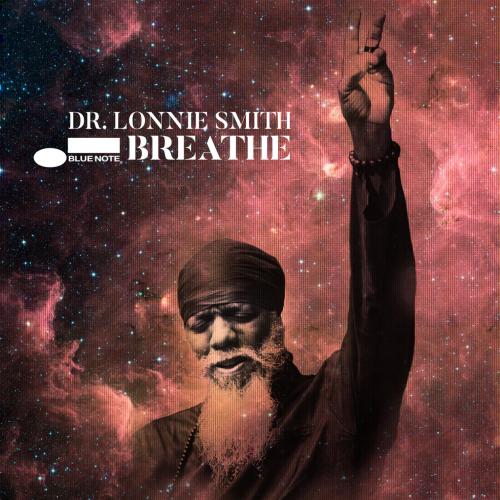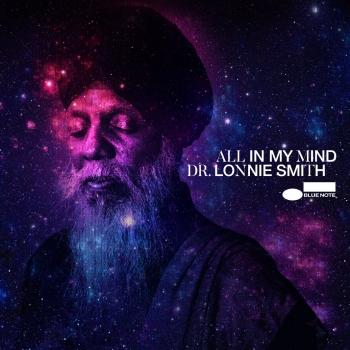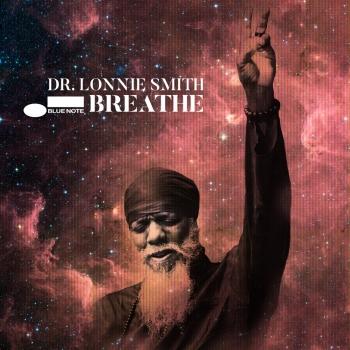
Breathe Dr. Lonnie Smith
Album info
Album-Release:
2021
HRA-Release:
26.03.2021
Album including Album cover
I`m sorry!
Dear HIGHRESAUDIO Visitor,
due to territorial constraints and also different releases dates in each country you currently can`t purchase this album. We are updating our release dates twice a week. So, please feel free to check from time-to-time, if the album is available for your country.
We suggest, that you bookmark the album and use our Short List function.
Thank you for your understanding and patience.
Yours sincerely, HIGHRESAUDIO
- 1 Why Can't We Live Together 07:44
- 2 Bright Eyes (Live) 07:25
- 3 Too Damn Hot (Live) 07:33
- 4 Track 9 (Live) 09:43
- 5 World Weeps (Live) 12:04
- 6 Pilgrimage (Live) 08:19
- 7 Epistrophy (Live) 04:22
- 8 Sunshine Superman 06:37
Info for Breathe
The legendary Hammond B-3 organist Dr. Lonnie Smith has recorded over thirty albums as a leader, but his favorite setting to document his creativity is live. “It’s so hard to capture what I’m feeling at the moment in the studio,” he says. “Hearing me live is catching me playing in the moment. It’s a good vibe. It’s a loving situation.”
During the 2017 celebration of his 75th birthday, basking in the glow of being named an NEA Jazz Master, Smith settled into the Jazz Standard in New York City for a live recording date. With his steady trio of guitarist Jonathan Kreisberg and drummer Johnathan Blake, the master of improvisational innovation delightfully delivered the spirited All In My Mind album, which was released in 2018.
That celebratory week has now yielded a second fantastic album with Breathe, a dynamic eight-song set that includes six thrilling pieces brimming with foot-tapping grooves, sophisticated harmonic voicings, indelible melodicism, and ethereal atmospherics that were captured on the Jazz Standard stage with the trio as well as an expanded septet. Notably, the album is bookended by two remarkable studio collaborations between Smith and the legendary vocalist Iggy Pop.
“I was playing with my trio at Arts Garage in Delray Beach in Florida,” says Dr. Lonnie, who lives in Ft. Lauderdale. “Iggy would come by and say he wanted to play with me. I let him play slaparoo and he loved it. He enjoyed playing with us. We thought about recording a few songs, so we went in with my trio backing us up, and it worked.”
Pop, Smith, Kreisberg, and Blake headed into a Miami studio with the addition of percussionist Richard Bravo and discovered a unique chemistry that resulted in two striking performances including the album’s opening track “Why Can’t We Live Together,” a 1972 R&B hit by Timmy Thomas that was later recorded by Sade on her 1984 debut album. With its call for unity, the song is given an eased, soulful read by Pop while Smith plays gentle grooves before diving into a juicy solo. “That’s a great tune with a great message,” he says. “It really says something to you. We enjoyed it very much.”
The album closes with Iggy and Dr. Lonnie taking Donovan’s 1966 hit “Sunshine Superman” for a funkified joyride. “Ah, hah!” exclaims Doc. “That’s another good one. You can hear the ones we both like. This fits his voice.”
The entire album is rooted in the deep musical communication Smith has developed with his trio mates over many years. “It’s hard to keep a working group like this,” the good Doctor says. “But my group has been together a long time. It’s a brotherhood. It’s a family. It’s exciting. They’re playing from their hearts. They know what I’m trying to do and enhance what I play. They hear me. I play in the moment all the time, and they’re there for me.”
In the trio takes from the Jazz Standard, Dr. Lonnie’s B-3 sounds like it’s wailing, as on the epic, soulful original “World Weeps” that goes up-tempo with a wall of organ emotion and Kreisberg’s fleet-fingered guitar flight. “It has a New Orleans feel,” says Doc, “like a dirge.”
The trio also takes a playful plunge into Thelonious Monk’s “Epistrophy.” “That’s one of my favorites,” Smith says. “I had to get that in there. It’s a little different, but I think he would have approved of it. There’s funky wisdom.”
The remainder of the album finds the trio expanded to a septet with the addition of John Ellis on tenor saxophone, Sean Jones on trumpet, Jason Marshall on baritone saxophone, and Robin Eubanks on trombone. “Some of my songs need the horns,” Smith says. “I needed that atmosphere.” The lyrical, buoyant “Bright Eyes” is a Dr. Lonnie original that dates back to the days when he played with George Benson. “Too Damn Hot” is another original that starts slowly but then heats up with sizzling solos. “I wrote that song some years ago,” he says. “I like all the surprises. It feels good, almost as if you don’t really know what’s going on.”
Smith’s “Track 9” starts with an edgy horn-filled groove then shifts gears with tempo acceleration that opens into a utopian party. The B-3 maestro steers the proceedings with his bass lines while Jones launches into a scorching solo. “It’s like a train, ‘Track 9.’ It moves like a train. You hear it in the distance, then there’s the horn and the beat is slow then it picks up. I wanted to give it a James Brown feel.”
“Pilgrimage” shines a spotlight on the soulful beauty of vocalist Alicia Olatuja. “Alicia is a helluva singer,” Smith says. “She is something else. The way she sings this song is perfect. She sings it like it’s hers. As her accompanist, my comping was just to lay back and take it easy. I listen carefully, give her what she needs then get the horns to push it. It’s special.”
Breathe is Smith’s third Blue Note album since his 2016 return to the label where he made a name for himself in the late 1960s, first as a sideman with saxophonist Lou Donaldson on soul jazz classics like Alligator Bogaloo, and soon after as a leader with his own classics such as Think! and Turning Point. The 2016 album Evolution marked his Blue Note homecoming, followed by All In My Mind in 2018. His last three albums have all been produced by Blue Note president Don Was. “Don has been hands on, there all the time,” he says. “He believes in you. I’ve worked with producers who don’t understand the musicians they’re working with. But Don, he wants me to be myself, to understand what I like to do. It’s a reminder of the old days when Frank Wolff used to be the same.”
Smith adds, “Blue Note is like family. It’s like I never left. Everybody is great to work with. They give me the opportunity to play my life, to tell my story.”
Dr. Lonnie Smith, organ
Jonathan Kreisberg, guitar
Johnathan Blake, drums
John Ellis, tenor saxophone
Sean Jones, trumpet
Jason Marshall, baritone saxophone
Robin Eubanks, trombone
Iggy Pop, vocals (tracks 1, 8)
Alicia Olatuja, vocals (track 6)
Dr. Lonnie Smith
is an unparalleled musician, composer, performer and recording artist. An authentic master and guru of the Hammond B-3 organ for over five decades, he has been featured on over seventy albums, and has recorded and performed with a virtual “Who’s Who” of the greatest jazz, blues and R&B giants in the industry. Consequently, he has often been hailed as a “Legend,” a “Living Musical Icon,” and as the most creative jazz organist by a slew of music publications. Jazz Times magazine describes him as “a riddle wrapped in an enigma wrapped in a turban!” Always ahead of the curve, it is no surprise Dr. Smith’s fan-base is truly worldwide.
Born in Buffalo, New York, Lonnie was blessed with the gift of music. Through his mother, he was immersed in gospel, blues and jazz at an early age. In his teens, he sang in several vocal groups including his own–the Supremes–formed long before Motown’s eventual iconic act of the same name. Lonnie also played trumpet and other instruments at school and was a featured soloist. In the late ‘50s– with the encouragement of Art Kubera, who owned a local music store that he would visit daily–young Lonnie was given the opportunity to learn how to play a Hammond organ. By completely immersing himself in the records of organists such as Wild Bill Davis, Bill Doggett and Jimmy Smith, as well as paying rapt attention to the church organ, a young Lonnie began to find his musical voice. “Even though I didn’t know how, I was able to play right from the beginning,” Dr. Smith reflects. “I learned how to work the stops and that was it. It’s a passion for me, so everything else came naturally.” Because of Mr. Kubera’s kindness, Dr. Lonnie often refers to Art as his “angel.”
The Doctor’s first gigs were at Buffalo’s hottest jazz club, the Pine Grill, where he rapidly garnered the attention of folks like Jack McDuff, Lou Donaldson, George Benson and the booking agent Jimmy Boyd. George Benson was looking for an organist for his quartet and enlisted Lonnie. The group soon relocated to New York City, where they quickly established a reputation as innovators in Harlem clubs and throughout the area. After appearing on several Benson albums, Lonnie went on to make his first recording as a leader—Finger Lickin’ Good–for Columbia Records in 1966. Shortly thereafter, Smith was scooped up to record by saxophonist Lou Donaldson, for whom Lonnie would appear on several epic Blue Note LPs, including the million-seller, Alligator Boogaloo. Blue Note clearly liked what they heard and inked the organist to his own recording contract, a deal which would produce the soul jazz classics Think!, Turning Point, Move Your Hand, Drives and Live at Club Mozambique (released many years later).
Since leaving the Blue Note stable in the ‘70s, Dr. Smith has recorded for a slew of record labels, including Kudu, Groove Merchant, T.K., Scufflin’, Criss Cross and Palmetto, ascending the charts many times. His unpredictable, insatiable musical taste illustrates that no genre is safe, as Lonnie has recorded everything from covers of the Beatles, the Stylistics and the Eurythmics, to tribute albums of Jimi Hendrix, John Coltrane and Beck–all by employing ensembles ranging from a trio to a fifteen-piece big band. Moreover, many of Doc’s recent compositions reflect dramatic ethereal qualities and orchestration that elicit movie scores or soundtracks.
Dr. Smith has been amused to find himself sampled in rap, dance and house grooves while being credited as a forefather of acid jazz. When questioned about his consistent interest in music some consider outside the jazz “mainstream,” Lonnie shrugs. “Jazz is American Classical,” he proclaims. “And this music is a reflection of what’s happening at the time… The organ is like the sunlight, rain and thunder…it’s all the worldly sounds to me!”
Many awards have followed since 1969, when Downbeat magazine named Dr. Lonnie Smith “Top Organist” of the year. 2003-2014 he was awarded “Organist/Keyboardist of the Year” by the Jazz Journalist Association. The Buffalo Music Hall of Fame and Jazz Organ Fellowship have also inducted Dr. Lonnie and in 2015 he will receive the Village Music Legends Award. In 2012, Dr. Smith launched his own record label Pilgrimage Inc., and in 2015, resigned with the iconic Blue Note Records label. Dr. Lonnie Smith’s next CD will be released on Blue Note in early 2016.
This album contains no booklet.












